Maximizing Reimbursement for New Patient Visits: CPT Code 99203

The 99203 code pertains to outpatient visits for new patients that necessitate a comprehensive history, examination, and low complexity decision-making. Correct application of this code will facilitate payment and prevent claims-related issues. This article will elucidate the components, time requirements, and frequent errors associated with the 99203 code, enabling you to utilize it accurately. Quick Hits The 99203 code is designated for new patient outpatient visits that demand a detailed medical history, examination, and low complexity medical decision-making for billing and compliance purposes. Accurate documentation of the essential components: patient history, physical examination, and medical decision-making is imperative for the application of CPT code 99203 and to ensure payment. Remaining informed about coding guidelines, reimbursement rates, and the application of modifiers such as 25 is crucial for precise billing and enhancing patient care and satisfaction. What is CPT Code 99203 CPT code 99203 is applicable for outpatient visits involving new patients that require a comprehensive medical history, examination, and low complexity medical decision-making. This code is relevant when the patient has not consulted the physician or another physician of the same specialty and group within the past three years, including other outpatient visit circumstances. This aspect is vital for coding and billing as it guarantees that the services rendered comply with the American Medical Association (AMA) standards. For the 99203 code, the necessary care components include a medically appropriate history, a detailed examination, and low complexity medical decision-making. These elements are essential to validate the code and receive payment for the services rendered. Grasping these components is crucial for coding and billing services and ensuring a seamless reimbursement process. The 99203 code serves as a fundamental element of medical coding that underpins the documentation and billing of initial patient visits. Proper utilization of this code guarantees coding compliance and enhances overall patient care by maintaining clear medical records. 99203 Components To bill under 99203, healthcare providers are required to document the following components. First, the patient’s medical history must be recorded, which includes: The patient’s chief complaint History of present illness Review of systems Past medical, family, and social history This serves as the foundation for understanding the patient’s current health status and potential risk factors. Next, a physical examination is necessary. It should be comprehensive, covering multiple organ systems, or a detailed examination of a single organ system if required. This examination provides a holistic view of the patient and aids in identifying any abnormalities that may require further investigation or treatment. The medical decision-making process for 99203 is classified as low complexity. This indicates that the decisions involved are not intricate. The provider must assess the patient, contemplate treatment options, and make decisions that are less complex than those associated with higher-level codes. Documenting this decision-making process is crucial as it substantiates the use of 99203 and the associated billing. Time Considerations for 99203 Time is an important factor in billing for 99203. Patient visits billed under this code generally last between 30 to 44 minutes. This duration encompasses face-to-face interaction with the patient as well as any additional time spent on the patient’s case, such as reviewing medical records or coordinating care with other providers. Accurate documentation of time is essential to demonstrate the level of care provided during 99203 visits. The documentation should clearly indicate the amount of time spent with the patient and the services rendered. This ensures that the billing accurately reflects the time and effort invested in patient care. Furthermore, precise time tracking supports the level of service billed and minimizes the risk of audits and denied claims. It reinforces the provider’s request for payment and guarantees that they receive compensation for the care they have delivered. 99203 vs 99204 vs 99205 Distinguishing between 99203 and the other new patient codes, 99204 and 99205, is essential for accurate billing and coding. 99203 pertains to low complexity, 99204 to moderate complexity, and 99205 to high complexity. Recognizing these distinctions aids in selecting the appropriate code for the patient visit. The duration of the encounter also differs among the codes. For instance, 99203 requires 30-44 minutes, while 99204 necessitates 45-59 minutes. These time specifications are crucial for selecting the correct code and ensuring that the billing accurately reflects the level of service provided. When selecting a code for billing, providers should take into account the complexity of medical decision-making, the thoroughness of the history and examination, and the time spent with the patient. By doing so, they can guarantee that the chosen code accurately represents the services rendered and facilitates payment. 99203 Documentation Accurate and comprehensive documentation is vital for successful billing of 99203. Providers must ensure that their documentation captures the depth of the history and examination. This encompasses the patient’s chief complaint and the history of the present illness. Additionally, it should include a review of systems and any pertinent past medical, family, and social history. Furthermore, providers should systematically document the medical decision-making process to substantiate the complexity of the patient’s condition. This involves assessing the patient’s status, weighing treatment options, and articulating the rationale for the selected plan of care. Such detailed documentation not only supports the application of 99203 but also safeguards against claim denials. Failure to align documentation with the billed level of service can lead to significant issues, including denied claims and audits. Therefore, providers must adhere to proper documentation practices to ensure their billing is precise and compliant with coding standards. 99203 Errors Billing mistakes are prevalent in the healthcare sector, and the 99203 code is no different. A frequent error involves billing this code for established patients rather than new patients, which may result in audits and penalties. Ensuring that the patient qualifies as a new patient is essential for accurate billing. Another error is the incorrect application of the 99203 code, which can lead to reduced reimbursement and diminished patient satisfaction due to inadequate service quality.
Why Practice Management Software Is Essential for Every Healthcare Practice in 2025
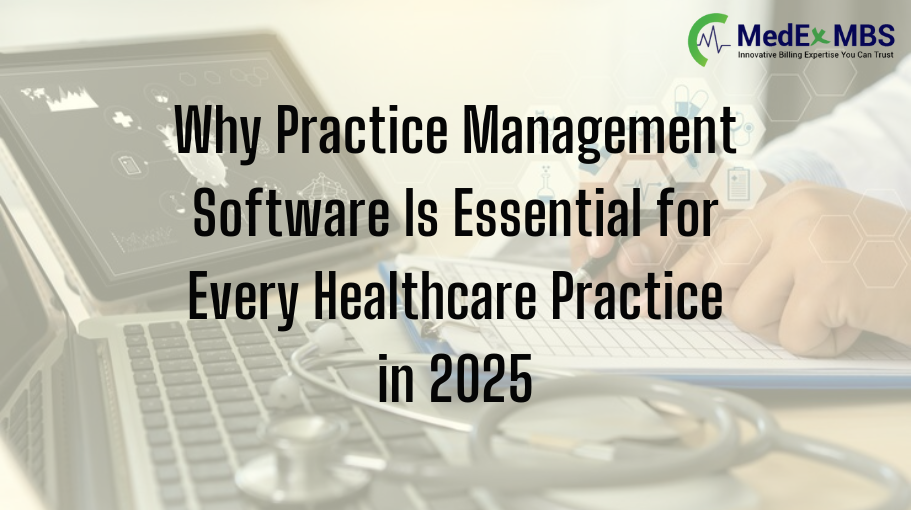
Not long ago, healthcare practices found themselves inundated with excessive paperwork, disconnected software, and processes that consumed more time than the actual care of patients. Imagine a small practice attempting to manage appointments on a whiteboard, keeping medical records on paper, and handling billing through scattered Excel sheets. This situation is chaotic, susceptible to mistakes, and significantly drains valuable time. Common issues included billing inaccuracies, missed appointments, prolonged patient wait times, and delayed payments. Additionally, the struggle to manually keep pace with regulations, codes, and insurance claims added to the frustration. Patients often faced difficulties in receiving timely care, while providers were overwhelmed by the disarray in their back-office operations. In this blog, we will outline how automation and intelligence can enhance every facet of your practice, encompassing financial, administrative, and more, through a cohesive practice management system. So, what is the challenge? Why is it imperative to adopt PMS at this moment? By 2025, the healthcare landscape is expected to undergo a significant transformation with the advancement of technology, prompting practices to adopt digital tools, such as practice management software, to streamline their operations. What was once considered a luxury has now become essential. These systems now consolidate everything from patient scheduling to billing and medical records, all within a single platform. No longer will there be isolated software or manual data entry. With PMS, practices can effectively manage appointments, enhance patient satisfaction, maintain billing accuracy, and ensure compliance with constantly changing regulations, all from one unified system. Let us explore the primary challenges faced by healthcare providers and how PMS is addressing these issues. Increased Administrative Burden and Operational Complexity Healthcare practices frequently face a significant burden of administrative responsibilities, and as the intricacies of care increase, the need for effective management also escalates. Personnel must oversee appointments, patient information, billing, coding, and insurance claims, all while ensuring adherence to various regulations. How PMS Assists: Automated Workflow: A practice management software system streamlines numerous administrative functions, such as scheduling appointments, verifying insurance, and submitting claims. For instance, by automatically dispatching patient reminders and handling cancellations, PMS diminishes no-show rates and enhances scheduling efficiency. Data Integration: All patient data, billing information, and scheduling are consolidated into a single platform, minimizing the time allocated to administrative duties and enhancing accuracy. Revenue Cycle Challenges and Claim Denials Errors in billing and coding continue to pose one of the most significant barriers to revenue collection. Claims are frequently rejected due to erroneous codes, incomplete details, or missed deadlines, which can critically impact a practice’s cash flow. How PMS Assists: Coding Accuracy and Real-time Validation: Contemporary practice management systems incorporate sophisticated coding frameworks and provide real-time validation, guaranteeing that claims are precise before submission. For example, a cardiology practice utilizing PMS can reduce its claim denial rate by 50% within six months due to the automatic validation of ICD-10 codes and payer-specific requirements. Faster Claims Submission: PMS accelerates the claims process by automating submission and tracking, thereby minimizing delays associated with manual entry. This enables practices to expedite their revenue cycle and decrease outstanding accounts receivable (AR). Data Security and Compliance with Evolving Regulations In 2025, healthcare practices must remain vigilant in safeguarding patient data and adhering to increasingly intricate regulations, such as the Health Insurance Portability and Accountability Act (HIPAA) and the 21st Century Cures Act. Non-compliance can lead to substantial fines and harm to a practice’s reputation. How PMS Assists: Robust Data Security: PMS platforms are equipped with advanced security features to safeguard sensitive patient information. Through encryption and multi-factor authentication, PMS aids healthcare practices in maintaining HIPAA compliance and security. Regulatory Updates: Practice management software automatically updates to align with evolving regulations, alleviating the need for practices to continually modify their processes. Whether it involves new CPT codes or alterations in insurance billing, these updates mitigate the risk of non-compliance. Patient Experience Expectations Patients are increasingly seeking convenience and transparency in their healthcare interactions. They anticipate easy access to their medical records, the capability to book appointments online, and prompt communication with providers. Practices that do not fulfill these expectations risk losing patients to competitors who offer a more efficient, digital experience. How PMS Assists: Patient Portals: PMS systems frequently feature patient portals that enable patients to access their medical records, schedule appointments, settle bills, and communicate with providers. Enhanced Communication: Automated reminders, follow-up messages, and straightforward access to appointment scheduling facilitate continuous communication between practices and patients, thereby improving their overall experience. Scalability and Adaptability As healthcare practices expand, the systems they utilize must scale and adjust without significant interruptions. Growing a practice, incorporating new providers, or introducing additional services can pose challenges if the management systems lack flexibility. How PMS Assists: Seamless Scaling: PMS systems facilitate the growth of practices without disruption. New locations or providers can be integrated effortlessly. For instance, a multi-location dental practice in New York can broaden its reach to several new sites while maintaining centralized management. This can result in a 15% decrease in overhead expenses across all locations. Adaptation to Value-Based Care: PMS solutions are designed to support the transition to value-based care by integrating with tools such as Electronic Health Records (EHR) and telemedicine platforms. Practice Management Software: An Essential Tool for the Future of Healthcare Practice management software has become indispensable for healthcare practices aiming to remain organized and efficient. If you are in search of the best practice management software at a reasonable price, supported by an expert team, reach out to MedEx MBS. Maximus, our PMS software, is designed to adapt to the evolving needs of your expanding practice, focusing on enhancing reimbursement rates and boosting profitability. It offers comprehensive insights into every phase of your revenue management process, enabling you to make informed decisions. Request a demo to discover how it can benefit your practice.
GW Modifier Vs. GV Modifier in Hospice Care

Are you facing challenges in receiving payment for healthcare services rendered to hospice patients due to the improper application of GW or GV modifiers? Don’t be concerned, we are here to assist you! Grasping the significance of the GW Modifier and GV Modifier is crucial for accurate hospice billing and preventing claim rejections. In this guide, we will elucidate all the essential information regarding these two vital billing codes, the usage of GW versus GV Modifiers, and their impact on your claims. However, before delving into the details, let us briefly discuss the concept of hospice care and the importance of these modifiers. What is Hospice Care? Hospice care refers to specialized medical care aimed at supporting patients with terminal illnesses, such as those with incurable or irreversible conditions, by prioritizing comfort and quality of life. It encompasses the provision of medications, medical attention, and equipment to alleviate pain and minimize suffering during the final phases of life. Hospice services are provided by a dedicated team of physicians, nurses, and caregivers who ensure that patients and their families receive emotional, physical, and spiritual support. Typical hospice care services include pain management, symptom control, counseling, and round-the-clock assistance. The objective is to enable patients to live peacefully and comfortably during their remaining time, whether at home, in a hospice facility, or in another care setting. Hospice care is not focused on curing the illness but rather on enhancing the quality of life for both patients and their families. A hospice care team may comprise the following members: Clergy or other counselors Home health aides Hospice physician Nurse Practitioners Social workers Trained volunteers Speech, physical, and occupational therapists, if necessary The patient’s physician The team undertakes numerous responsibilities to assist and care for patients with terminal illnesses, including: Managing the patient’s pain and recognizing symptoms Offering emotional support Supplying medications, medical supplies, and equipment Educating caregivers on how to care for the patient Providing additional assistance, such as speech or physical therapy when necessary Facilitating short-term inpatient care when pain or symptoms escalate beyond manageable levels at home Offering grief support Where is Hospice Care Provided? Hospice care is offered in a variety of environments, such as hospitals, specialized hospice facilities, nursing homes, or the patient’s residence. A significant number of patients prefer the solace of receiving care in their own homes. Individuals who are enrolled in Medicare are eligible for hospice services if their physician assesses that they may have six months or less to live due to a terminal illness. This assessment is based on the patient’s medical history and overall health condition. Although it is difficult for physicians to accurately forecast life expectancy, patients who exceed the six-month mark can temporarily exit hospice care and re-enter later if their physician re-certifies their eligibility. Medicare beneficiaries have the option to transition from standard Medicare coverage to hospice care, which emphasizes symptom management and ensuring that patients are comfortable and treated with dignity during this period. When individuals on Medicare opt for hospice care, they can receive assistance with costs related to their illness through Medicare Part B. However, this does not include services provided by their primary doctor or nurse practitioner. Here are several requirements for the provision of hospice care services. They include: Patients (Medicare Beneficiaries) are required to opt for hospice care instead of standard Medicare benefits, and their terminal illness must be validated by both their attending physician and the medical director or a physician member of the IDG (Interdisciplinary Group). Nurse practitioners (NPs) serving as the attending physicians for the patient are not permitted to certify or recertify the terminal illness. Specific hospice care must be organized before the delivery of any services to terminally ill patients, and the care services must correspond with the established care plan. It is crucial to keep in mind that predictions regarding life expectancy are not always precise. Utilizing GV and GW Modifiers in Hospice Care Grasping the significance of GV and GW modifiers is vital for accurate hospice billing. These modifiers serve to clarify claims for services associated with a hospice patient’s care, thereby aiding in ensuring they are processed and reimbursed appropriately. Below is an overview of essential information regarding the application of GV and GW modifiers for hospice claims. Hospice Modifier GV The GV modifier for hospice claims is critical when billing Medicare for services rendered to hospice patients. This modifier is applicable when care services pertain to the patient’s terminal condition, yet the attending physician or nurse practitioner (NP) is not directly employed or compensated by the hospice agency. For example, if a physician delivers medical care to a hospice patient and is not associated with the hospice, but the services relate to the patient’s terminal illness, Medicare can still reimburse the physician. To guarantee proper reimbursement, the provider must incorporate the GV modifier on the claim when submitting it to Medicare. Key considerations when incorporating Modifier GV: Incorporating a GV modifier into claims will be advantageous for non-hospice physicians. The application of GV modifiers by hospice contractors is appropriate only if the patient qualifies for hospice care. Nevertheless, the attending physician must not be affiliated with the hospice as an employee. Hospice Modifier GW The GW Modifier plays a crucial role in billing Medicare for services rendered to hospice patients that are not related to their hospice care. This modifier is applicable when a patient eligible for hospice receives treatment for conditions that are not associated with their hospice diagnosis. For instance, if a patient in hospice care requires medical services for an unrelated issue, the healthcare provider must apply the GW Modifier when filing claims with Medicare. This specifically pertains to services delivered by physicians who are neither employed by nor compensated by the hospice. Essential points to remember regarding the GW Modifier: Apply the GW modifier to signify that the services rendered to a hospice patient are outside
CPT Code 99459: New Billing Rules and Reimbursement Changes for 2025
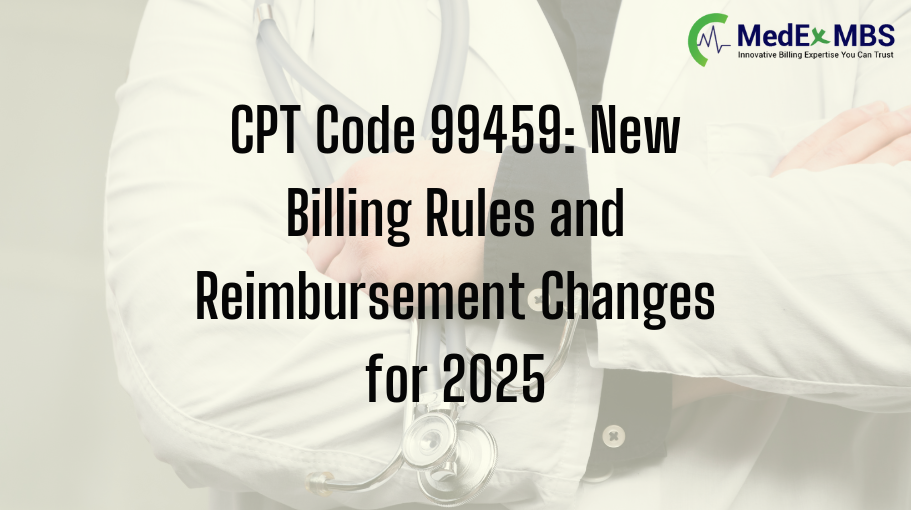
CPT code 99459 was introduced on January 1, 2024, and serves as an add-on code for pelvic examinations conducted alongside an E/M service. This code accounts for the practice expenses related to the pelvic exam, which includes the time of clinical staff and necessary supplies. As an add-on code, 99459 must be reported in conjunction with a primary E/M code and cannot be billed independently. Important Notes: 99459 is an add-on code; it cannot be billed independently and must be associated with a primary E/M service. It encompasses staff time, equipment, and disposable supplies, but does not include the physician’s work. Adequate documentation is essential to validate its use and ensure compliance. The pelvic examination must be deemed medically necessary or included as part of a preventive visit. Coverage may differ by payer, so it is advisable to review insurance policies in advance. CPT Code 99459 Description The intent of CPT code 99459 is to account for the additional practice expenses incurred during a pelvic examination. This encompasses the costs of supplies such as speculums, gowns, and drapes, as well as the clinical staff’s time for activities like chaperoning the patient throughout the examination. This code does not encompass the physician’s work during the examination; it solely addresses the ancillary costs associated with the procedure. Notably, this code does not cover the physician’s work during the examination; rather, it is focused exclusively on the ancillary costs linked to the procedure. Applying CPT Code 99459 CPT code 99459 is designated as an add-on code for outpatient or well-patient office visits, making it applicable in various situations such as screening and annual wellness visits when the examination is warranted. Given that it is an add-on code, it cannot be billed independently and must be reported alongside a primary service code on the same date of service. This code may be added to a specified range of services, which includes both new and established patient visits, consultations, and wellness examinations, in accordance with CPT coding regulations. Typically, Medicare and private insurers adhere to this list; however, Medicare may expand it to include additional G codes for annual wellness visits or “Welcome to Medicare” examinations. As the guidelines for coverage and coding regulations evolve, healthcare providers must remain updated to guarantee accurate billing and compliance. Situation: A 16-year-old female patient presents with irregular menstrual cycles. After reviewing her medical history, the physician concludes that a pelvic examination is warranted. A female nurse is present to serve as a chaperone. Billing: Primary E/M code: 99203 (New patient office visit, low complexity) Add-on code: 99459 (To account for the extra practice costs associated with the pelvic examination) Key Considerations: Obtaining consent is crucial, particularly for minors. The provider should clarify the purpose of the examination and ensure the patient’s comfort. Should the patient refuse the examination, this should be documented, and code 99459 would not be billed. Appropriate Usage of CPT Code 99459 CPT code 99459 is applicable when a pelvic examination is conducted as part of an E/M service within an office environment (Place of Service 11). CPT code 99459 is utilized when a pelvic examination is performed as part of an E/M service in an office context, frequently managed through specialized physician billing services. The following E/M service codes may be reported alongside CPT code 99459: Office or Other Outpatient Visits for New Patients: 99202–99205 Office or Other Outpatient Visits for Established Patients: 99212–99215 Consultation Codes: 99242–99245 Preventive Medicine Services New Patients: 99383–99387 Established Patients: 99393–99397 For Medicare patients receiving preventive visits, the relevant HCPCS codes are: G0402: Initial preventive physical examination; face-to-face visit, services are restricted to new beneficiaries within the first 12 months of Medicare enrollment. G0438: Annual wellness visit; encompasses a personalized prevention plan of service (PPPS), initial visit. G0439: Annual wellness visit; encompasses a personalized prevention plan of service (PPPS), subsequent visit. However, there is currently no official guidance regarding the reporting of CPT code 99459 in conjunction with these specific HCPCS codes. CPT 99459 Billing Guidelines for 2025 To ensure payment, adhere to the following 2025 guidelines: Pair it with an appropriate E/M code: Thoroughly document: The rationale for performing the pelvic exam, details regarding the chaperone (if applicable), and the involvement of supplies and staff. Review payer-specific regulations: Certain insurance plans may bundle this code with an E/M visit. Medicare may impose different coverage restrictions. Prevent billing mistakes: 99459 cannot be billed as an independent service. Ensure it is medically necessary. Documentation Requirements Precise documentation is essential when reporting CPT code 99459. The medical record must explicitly indicate that a pelvic examination was conducted as part of the E/M service. If a chaperone was present during the examination, record the chaperone’s name, role, and the duration of their involvement. If a chaperone was offered but declined by the patient, this should also be documented. Proper documentation guarantees adherence to billing regulations and substantiates the medical necessity of the service rendered. Situation: A 45-year-old woman presents for a well-woman examination. The provider conducts a comprehensive preventive examination, including a pelvic exam. A chaperone is present during the examination to ensure the comfort of the patient. Billing: Primary E/M code: 99386 (Preventive visit for new patient, aged 40–64) Add-on code: 99459 (To capture the cost of supplies and staff time during the pelvic exam) CPT 99459 Reimbursement As a practice expense only code, CPT 99459 is assigned a value of 0.68 relative value units (RVUs) for non-facility settings. This valuation accounts for approximately 4 minutes of clinical staff time required to accompany the pelvic exam, as well as the cost of supplies such as a speculum. It is important to note that this code does not encompass physician work RVUs, as it pertains solely to practice expenses. When submitting a claim for CPT 99459, it must be listed separately and in addition to the primary E/M service code. Ensure that the primary procedure code accurately reflects the E/M service, and that CPT 99459 is appropriately linked to that
5 Key Updates to Podiatry CPT Codes in 2025 Every Podiatrist Should Know
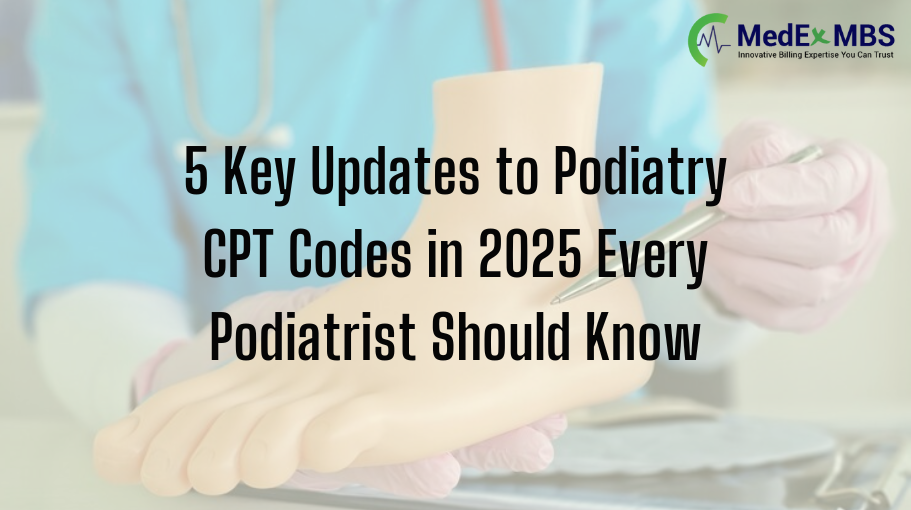
In 2025, the American Medical Association implemented significant modifications to the podiatry CPT codes. Podiatrists are advised against using the previous billing methods, as this may jeopardize their claims, leading to denials, delays, and potential revenue loss. The introduction of new telemedicine codes, the elimination of outdated telephone codes for E/M and wound care, along with remote monitoring, is transforming the documentation process for podiatrists regarding patient care. These coding updates necessitate that podiatrists familiarize themselves with the codes applicable to virtual consultations, wound management, and patient remote monitoring. To avoid extended delays in payment due to erroneous claims, clinics are required to update their billing practices, train their staff, and improve documentation. Whether submitting a claim for a toe amputation (CPT code 28810, CPT 28820), an annual nail debridement (CPT code 11721), or a virtual consultation in podiatry, it is crucial to be aware of these changes; ignorance is not an acceptable stance. This blog will detail the five key changes affecting your standard podiatry CPT codes, elucidate their underlying reasons, and provide guidance on their effective implementation to protect reimbursements and ensure compliance in 2025. New Telemedicine CPT Codes for Foot & Office Visits Podiatrists frequently consult with patients via video or phone. In 2025, new telemedicine codes were introduced for these types of visits. The CPT code set now includes codes 98000–98015 for real-time virtual patient interactions. These new codes enable physicians to bill for video consultations (for new patients: 98000–98003; for returning patients: 98004–98007) and audio-only phone consultations (for new patients: 98008–98011; for returning patients: 98012–98015). Podiatrists are required to utilize these new codes whenever a consultation occurs via live video or phone. This update supersedes the previous approach of merely appending a modifier to a CPT code for a podiatry office visit; now, distinct telemedicine codes must be employed. Deletion of Old Telephone E/M Codes With the introduction of new telemedicine codes, the previous telephone-only evaluation and management codes have been eliminated. The podiatry CPT codes 99441–99443, which were utilized for doctor-patient phone consultations, were officially removed as of January 1, 2025. Consequently, podiatrists are advised against submitting codes 99441–99443 on their claims. Instead, if a phone consultation qualifies as a patient visit, the physician will employ one of the newly established audio-only telemedicine codes (98008–98015) mentioned earlier. This transition ensures that physicians utilize the most current CPT codes for virtual healthcare. New Virtual Check-In Code CPT 98016 Additionally, there is a new code designated for brief patient-initiated check-ins. In 2025, HCPCS G2012, the previous code for a short patient phone check-in, was abolished. It has been succeeded by CPT code 98016. This code encompasses a “brief communication technology-based service” with an established patient. This service involves a 5–10 minute telephone or video call initiated by the patient, during which the physician provides advice or triages the issue. Video is not a requirement for code 98016, and it is applicable only if the patient contacts the doctor more than 7 days after an in-person visit, and it does not result in an immediate follow-up. Podiatrists can now utilize code 98016 in place of the former G2012 for short virtual check-ins. New Skin Cell Suspension Autograft Codes (15011–15018) Podiatrists addressing severe foot wounds, such as significant burns or diabetic ulcers, now have new coding options available in the CPT manual. In 2025, a series of codes for “skin cell suspension autografting” was introduced. These are podiatry CPT codes 15011–15018, which describe an innovative procedure where a small skin sample is transformed into a cell “spray” that can cover a larger wound area. For instance, a small skin sample measuring 1 cm² can be utilized to treat a wound of 80 cm², such as a significant foot ulcer. The codes 15011–15014 pertain to the harvesting and preparation of skin cells, while codes 15015–15018 relate to the application of these cells onto the wound. Podiatrists managing intricate foot wounds are now able to utilize these specific codes rather than relying on more generic graft codes. Updated Digital Health Monitoring Codes (98975–98978) The update for 2025 has also modified the codes associated with remote patient monitoring and digital therapy, which may affect the field of podiatry. The changes made by the AMA to the CPT indicate that CPT 98975 has been amended to encompass “digital therapeutic intervention,” and codes 98976–98978 have been revised to account for the provision of devices or applications utilized in patient monitoring. In straightforward terms, this signifies that there is now formal CPT acknowledgment for digital health instruments (such as home foot monitors or therapeutic applications) employed in patient care. A podiatrist who oversees a patient’s foot health through a digital program or device may apply these codes. These revisions ensure that the CPT system remains aligned with emerging health technologies. Podiatry CPT Codes: 2025 New & Removed Codes Code Range Short Name When to Use Note 99441 / 99443 Deleted telephone E/M codes Do not submit; phone codes removed. Deleted Jan 1, 2025; use 98008–98015 for audio-only visits. 98016 Virtual check-in (brief) Short 5–10 min patient-initiated phone/video check-ins. Replaces HCPCS G2012; use only if not leading to an immediate visit. 15011 / 15018 Skin cell suspension autograft For harvesting, preparing, and spraying skin-cell grafts on large wounds. Use for complex foot wounds (e.g. diabetic ulcers) instead of generic graft codes. 98975 / 98978 Digital health / remote monitoring For monitoring devices or digital therapeutic programs. Use when a device or app is part of patient monitoring or therapy. 11721 Nail debridement (6+ nails) When medically necessary, nail debridement of 6 or more nails is done. Document the nail and medical reason (infection, pain, ADL impact). 28810 / 28820 Toe amputation CPT
How Automated Insurance Verification is Reshaping Healthcare Revenue in 2025
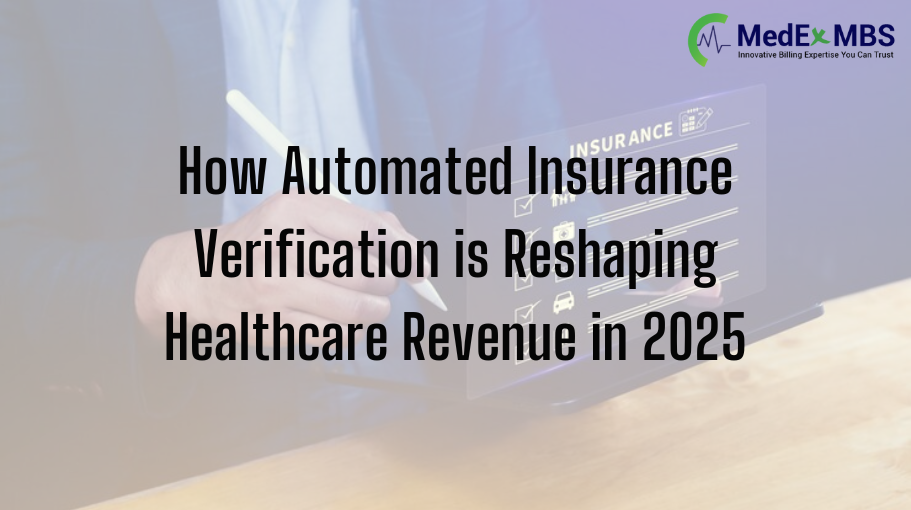
Healthcare organizations incur losses amounting to millions annually due to a single administrative bottleneck that many could resolve. Each phone call made by your staff to confirm insurance coverage squanders valuable resources, consuming 25-30% of front desk time and introducing human errors that lead to expensive claim denials. The answer lies in automated insurance verification systems, which eliminate manual tasks and provide real-time eligibility information with unmatched precision. These platforms seamlessly integrate with electronic health records, connect directly to insurance databases, and verify coverage in seconds rather than minutes. This guide outlines how automated insurance eligibility verification can decrease claim denials by as much as 40%, save 3-5 hours each day for every staff member, and avert millions in revenue losses while enhancing patient satisfaction and operational efficiency. What is Automated Insurance Verification Automated insurance verification represents a significant departure from the traditional manual verification processes that have burdened healthcare providers for many years. This technology employs specialized software to electronically verify patient insurance eligibility, substituting labor-intensive phone calls and fax communications with immediate digital connectivity. The essential elements of these systems include real-time database connectivity with payer systems, smooth integration with current electronic health records, and batch processing capabilities that allow for the verification of hundreds of patients simultaneously during off-peak hours. In contrast to manual methods that require 5-7 minutes per patient verification with error rates of 15-20%, automated solutions yield results in 2-3 seconds with accuracy rates exceeding 99.5%. The market for insurance verification software is expanding rapidly, with projections indicating it will reach $11.4 billion by 2027. This expansion is attributed to the necessity for healthcare providers to digitize their administrative operations and adhere to evolving healthcare regulations while navigating intricate payer environments. Contemporary verification software interfaces directly with major insurance companies via secure APIs, obtaining real-time eligibility information from Aetna, Cigna, UnitedHealthcare, Medicare, and Medicaid systems. These systems are capable of verifying over 500 patients during off-peak hours and securing complete coverage validation prior to the commencement of business hours. The Burden of Manual Insurance Verification The process of manual verification imposes a significant administrative load that extends beyond mere time consumption. Front desk personnel dedicate 25-30% of their daily activities to verification-related phone calls, creating bottlenecks that hinder patient flow and satisfaction. Each manual verification attempt consumes 5-7 minutes per patient, during which staff must navigate complicated phone systems, endure hold times, and manually record insurance details that are susceptible to human error. The financial repercussions are even more severe. The rate of human error in manual data entry ranges from 15-20%, leading to inaccuracies in patient records and insurance details. These inaccuracies are directly responsible for 8-12% of all claim denials, prolonging payment cycles by 45-60 days as claims must be resubmitted and rectified. Financial Consequences for Healthcare Organizations Large healthcare institutions bear the brunt of these issues, with eligibility-related claim denials threatening an annual revenue loss of $3-5 million. Smaller practices are not exempt; they face a 15-25% decrease in cash flow due to inefficiencies in verification processes and administrative expenses that accumulate to $12-18 for each patient encounter. The cascading effects persist, with staff overtime costs rising by 20-30% as teams endeavor to manage verification backlogs and reprocess denied claims. Manual verification generates operational bottlenecks that hinder staff from concentrating on higher-value tasks that have a direct influence on patient care and satisfaction. Administrative expenses accumulate when one considers the entire range of manual processes. In addition to labor costs, organizations must factor in communication expenses, documentation overhead, and the opportunity cost associated with delayed patient services. Numerous healthcare organizations discover that their administrative bottlenecks adversely affect their financial performance and hinder their ability to enhance cash flow. How Automated Verification Functions Automated verification platforms operate via real-time database connectivity, accessing insurer systems within 2-3 seconds and providing instant eligibility confirmation through secure API integration. These systems connect with over 1,000 payers, including Aetna, Cigna, UnitedHealth, and government programs, ensuring comprehensive coverage validation across various insurance landscapes. The technology facilitates batch processing of more than 500 patients simultaneously during off-peak hours. This method guarantees that patient verification occurs prior to appointments, minimizes disruptions during busy clinical hours, and optimizes system efficiency. Sophisticated platforms offer automated alerts and notifications regarding coverage changes, pre-authorizations, and policy expiration dates. These proactive features assist healthcare providers in staying ahead of billing challenges and ensuring that patient insurance information remains up-to-date throughout the care relationship. Pre-Service Verification Procedure The most advanced automated systems arrange verification checks 24-48 hours before patient appointments, identifying potential coverage issues before patients arrive. This pre-service strategy enables staff to address issues proactively, thereby reducing appointment delays and enhancing the patient experience. During the pre-service verification process, systems evaluate coverage details, including copays, deductibles, and benefit limitations, before service delivery. This thorough analysis allows staff to provide patients with accurate out-of-pocket costs, improving transparency and minimizing billing surprises that could affect patient satisfaction. Insurance discovery features represent a crucial capability, enabling the identification of additional coverage from external databases for patients who initially appear as self-pay accounts. Since one in six Medicare and Medicaid patients undergo coverage changes monthly, it is vital to engage in continuous monitoring to uphold accurate eligibility data and minimize claim denials. Key Benefits of Automated Insurance Verification The shift from manual processes to Automated Insurance Verification (AIV) yields significant enhancements across various operational domains. The most immediate advantage is the reduction of errors, with automated systems achieving accuracy rates of 99.5%, in contrast to the 80-85% accuracy of manual verification methods. This enhancement in data quality results in fewer claim rejections and a more streamlined revenue cycle. Another substantial benefit is the time savings, as automated systems can decrease verification time by 4-6 minutes for each patient encounter. This increase in efficiency enables administrative personnel to concentrate on patient care activities and other high-value tasks that enhance overall practice operations and patient satisfaction. Financial protection stands out as perhaps the most significant advantage, with automated verification
Frequent HCPCS Coding Errors in Radiology Billing and Strategies to Prevent Them
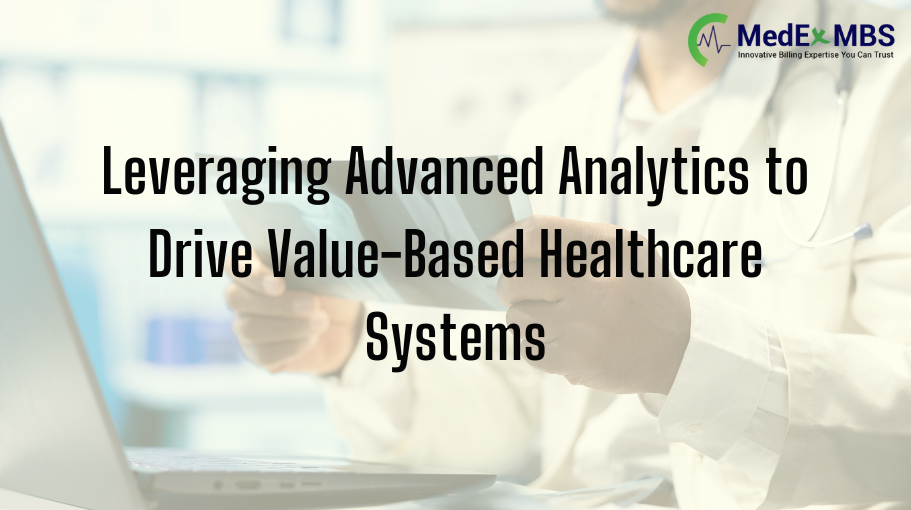
Radiology practices frequently neglect to apply separate charges for essential items, including imaging supplies, contrast dye, and radioactive tracers, as their attention is primarily directed towards the main scans and diagnoses. When personnel fail to bill for these expensive materials, practices experience revenue loss and face the risk of compliance violations. A single mistake in billing for a radioactive tracer can result in costs exceeding $1,000 per study. With Medicare reimbursement rates projected to decrease by approximately 2.9% in 2025, these HCPCS challenges are increasingly significant for radiology professionals. This guide outlines prevalent HCPCS challenges and effective strategies to address them. Why is HCPCS Essential in Radiology Billing? CPT codes document the procedures performed, such as MRI scans, CT studies, or PET scans. In contrast, HCPCS codes account for the materials utilized, such as the $2,000 PET tracer, the $300 gadolinium injection, or specialized catheters. Failing to include these supply codes results in the expensive materials being treated as practice overhead rather than being compensated for. This issue is a common occurrence in radiology. Practices tend to concentrate on the high-cost imaging procedures while disregarding the costly materials that enable those procedures to be performed. The most frequent areas where practices incur revenue losses include: Contrast Agents Each type of contrast requires specific HCPCS codes that depend on its composition and delivery method. Gadolinium-based MRI contrast necessitates different codes compared to iodinated CT contrast. Utilizing generic codes instead of the specific agent codes leads to systematic underpayments. Radiopharmaceuticals PET imaging depends on costly tracers that come with intricate billing regulations. Some codes charge per study dose, irrespective of the millicuries used, while others charge per millicurie administered. This differentiation influences whether you bill for one unit or fifteen units for the same injection. Interventional Supplies Catheters, guidewires, and specialized devices employed during interventional procedures are often eligible for separate billing. Omitting these charges can convert profitable procedures into scenarios where the practice breaks even or incurs losses. Frequent HCPCS Coding Errors in Radiology Billing The following outlines the most common HCPCS errors encountered in radiology billing, along with their respective solutions. Incorrect Units for Radiopharmaceutical Billing Radiopharmaceutical codes adhere to distinct billing regulations that many practices misinterpret, resulting in considerable revenue loss. The Issue Certain codes bill “per study dose, while others bill “per millicurie. Code A9503 encompasses up to 30 millicuries but bills as a single unit, irrespective of the actual quantity utilized. Numerous practices mistakenly bill 15 units when administering 15 millicuries. The Resolution Educate staff to distinguish between “per study dose” and “per millicurie” descriptors. Develop quick reference cards that outline unit rules for frequently used radiopharmaceuticals. Insufficient Documentation for High-Cost Tracers Unlisted tracer codes necessitate comprehensive documentation that many practices neglect, leading to claim denials. The Issue Codes such as A9598 require documentation of the product name, NDC number, dosage, and invoice cost. The absence of any of these elements results in denials. Random audits demand invoice verification, and incomplete records necessitate the repayment of received funds. The Resolution Establish documentation templates for unlisted codes. Mandate the inclusion of invoice copies and complete product information before billing any NOC radiopharmaceutical codes. Billing for Contrast When It Is Already Included Payer bundling regulations differ significantly, confusing regarding when contrast can be billed separately. The Issue Certain payers bundle MRI contrast into procedure payments. Billing it separately breaches contracts and initiates compliance reviews. Each payer has varying bundling rules that are subject to change quarterly. The Resolution Keep up-to-date bundling reference guides for major payers. Review payer updates every quarter and modify billing protocols accordingly for each contract. Insufficient Contrast Documentation Details Inadequate contrast documentation hinders accurate HCPCS coding and leads to systematic revenue loss. The Issue The type and quantity of contrast must be recorded in the technique section prior to the addition of supply codes. Incomplete information regarding specific contrast agents, volumes given, or methods of delivery hinders precise HCPCS code selection and reimbursement. The Resolution Mandate that technologists record the precise type of contrast, volume, and method of administration. Develop standardized templates for documenting contrast in imaging reports. Prior Authorization Shortcomings for High-Cost Agents High-priced radiopharmaceuticals and contrast agents frequently necessitate prior authorization, which practices often neglect to secure. The Issue Advanced PET tracers, which cost between $3,000 and $5,000, require pre-approval before administration. The absence of authorization results in automatic denials, irrespective of medical necessity. Emergency studies exacerbate this issue when time constraints prevent authorization requests. The Resolution Establish pre-authorization tracking systems for high-cost agents. Confirm coverage before scheduling and maintain databases for authorizations with tracking for expiration. Billing System Mapping Mistakes Chargemaster systems frequently misclassify procedures under incorrect HCPCS codes, leading to systematic billing inaccuracies. The Issue Technical personnel document bilateral imaging on charge tickets, yet billing systems assign unilateral procedure codes. Therapeutic infusions are incorrectly categorized under hydration codes. These mapping inaccuracies result in consistent underbilling across numerous claims. The Resolution Perform quarterly audits of the chargemaster with both clinical and billing personnel. Cross-verify charge ticket descriptions against the actual HCPCS codes in your billing system. When discrepancies are identified, promptly update mappings and utilize test claims to validate corrections before implementation. Volume Calculation Errors Inaccurate dosage calculations result in incorrect unit billing and substantial revenue discrepancies. The Issue Per-milliliter codes necessitate accurate volume calculations. Billing practices that charge per vial rather than the actual milliliters administered overlook potential revenue. Additionally, the requirements for waste documentation further complicate the precise determination of units for costly agents. The Resolution Educate staff on the differences between per-unit and per-volume billing. Establish protocols for verifying dose calculations. Ensure proper documentation of waste for high-cost radiopharmaceuticals. Incomplete Invoice Records for Audits The absence of invoice documentation poses a risk during payer audits and
Leveraging Advanced Analytics to Drive Value-Based Healthcare Systems
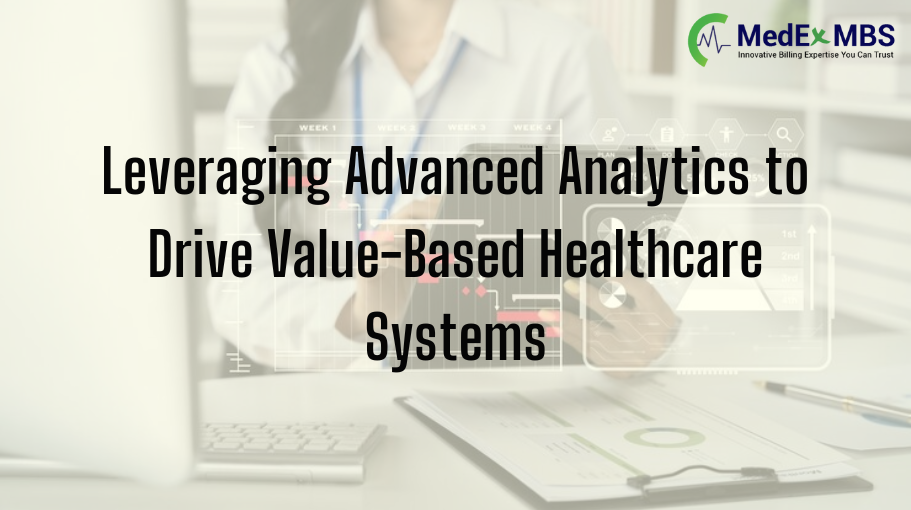
Healthcare systems worldwide have experienced a transition from the conventional fee-for-service model to a more patient-focused approach aimed at enhancing patient healthcare outcomes, exemplified by the Value-Based Healthcare (VBHC) model. This model, driven by patient outcomes, seeks to emphasize the quality of healthcare, as payers reimburse providers based on the value and results of the care delivered. Payers set quality standards and objectives that providers must achieve to qualify for full reimbursement; failure to meet these standards can lead to significant penalties. In this blog, we will examine the significance of advanced analytics within a value-based healthcare framework and how it contributes to improved patient outcomes alongside cost management strategies. Additionally, we will review the challenges and advantages of integrating advanced analytics into healthcare delivery, supported by real-world examples demonstrating their positive impact. What is Value-Based Analytics? Value-based analytics involves the application of advanced technologies, including machine learning, artificial intelligence (AI), and data mining, to evaluate and manage risks. By scrutinizing extensive datasets, these technologies yield actionable insights that enhance healthcare delivery, optimize patient outcomes, and ensure quality and affordability. In contrast to traditional data analysis, which typically emphasizes descriptive statistics and historical data, advanced analytics employ sophisticated algorithmic techniques to forecast future events and outcomes, provide problem-solving recommendations, and identify patterns that may not be immediately apparent. In the field of healthcare, advanced analytics entails the examination of extensive patient data (including clinical, demographic, behavioral, etc.) through the following methods: Predictive Analytics: This involves identifying patients who may be at risk of developing chronic conditions or facing readmission to the hospital. Prescriptive Analytics: This method recommends specific interventions or care plans tailored to patient health data and characteristics. Descriptive Analytics: This involves the analysis and reporting of key performance indicators (KPIs) to yield insights into patient care outcomes and related costs. How Advanced Analytics Enhances Value-Based Healthcare • Enhancing Patient Health Outcomes Advanced analytics models have the potential to significantly enhance patient outcomes by forecasting health risks, pinpointing possible complications, and striving to avert future issues. For instance, predictive models can detect patients at high risk for chronic conditions, readmissions, or adverse events based on historical data. Consequently, healthcare providers can implement earlier interventions through personalized care plans to mitigate these adverse outcomes, thereby improving overall health and quality of life. Moreover, analytics tools can continuously monitor patients, notifying clinicians of any changes in a patient’s condition. This data-driven methodology facilitates timely modifications to care plans, ensuring that patients receive the most suitable care at the appropriate time. • Optimizing Healthcare Expenses: A primary objective of value-based healthcare is to lower the overall cost of care while preserving or enhancing outcomes. Advanced analytics aids in cost management by uncovering inefficiencies, such as unnecessary tests or clinical procedures, and assisting healthcare organizations in optimizing their revenue cycle. Predictive analytics can foresee patient requirements and avert hospital readmissions, which can impose a considerable financial strain on both patients and healthcare systems. By examining trends in patient behavior and treatment results, value-based analytics tools can pinpoint the most effective and cost-efficient models, thereby assisting providers in delivering superior care at reduced costs. • Customized Care Plans: Each patient possesses unique characteristics, and what may be effective for one individual might not be suitable for another. Advanced analytics empowers healthcare providers to tailor treatment plans according to individual patient data and medical history. By integrating clinical data with demographic and lifestyle information, prescriptive analytics tools can aid clinicians in formulating personalized care plans that address specific health concerns, resulting in more effective treatments and enhanced outcomes. This tailored approach is also in harmony with the value-based care model, ensuring that treatments are both necessary and suitable, thereby preventing over-treatment and minimizing the risk of harm from unnecessary procedures. • Data-Driven Decision-Making: In a value-based healthcare framework, providers frequently face the necessity of making intricate decisions influenced by a multitude of factors, ranging from patient history to the most recent research findings. Descriptive analytics can facilitate informed medical decisions by offering evidence-based insights, enabling healthcare providers to make more suitable data-driven choices. AI-driven decision support tools can also recommend the most effective treatments based on patient data, while machine learning algorithms can uncover patterns in patient health that may not be readily apparent. This empowers clinicians to make more precise and timely decisions, ultimately resulting in improved patient outcomes. • Measuring Care Value: In a healthcare system focused on value, success is determined not by the quantity of services rendered but by the satisfaction outcomes of patients. Advanced analytics can assist healthcare organizations in evaluating and monitoring the genuine value of care by examining the correlation between patient outcomes and care costs. By assessing both quality and expenses, descriptive analytics enables organizations to pinpoint which practices offer the greatest value to patients. Case Studies and Examples: Practical implementations of advanced analytics in value-based healthcare are already yielding remarkable results. For instance: 1. Predicting Hospital Readmissions: Numerous hospitals employ predictive analytics to identify patients who are at risk of being readmitted within 30 days post-discharge. For example, certain hospitals have effectively utilized machine learning models that scrutinize patient data, including prior medical history, comorbidities, and discharge notes, to forecast which patients are most likely to return. This empowers healthcare providers to be proactively informed with additional care or follow-up, thereby mitigating readmission challenges and enhancing patient outcomes. 2. AI Technology in Oncology: In the field of oncology, AI is utilized to tailor cancer treatment. By examining data from medical records, genetic profiles, and clinical trials, AI algorithms can propose personalized treatment plans suited to individual patients. This aids oncologists in selecting the most effective therapies, ensuring proper scheduling, and increasing the likelihood of successful outcomes. 3. Improving Population Health Management: Healthcare organizations are leveraging advanced analytics to discern patterns and trends within extensive patient populations, allowing for more effective management of chronic conditions. By analyzing patient data across entire communities, providers can establish proactive care programs aimed at at-risk populations, ultimately reducing overall healthcare
Top 7 Advantages of Embedded BI in Healthcare

The healthcare sector is a field characterized by continuous changes driven by new technologies and methodologies aimed at enhancing patient care and optimizing administrative processes. A notable advancement in this area is healthcare business intelligence, which incorporates integrated analytic tools for data analysis. Healthcare BI significantly enhances the efficiency and effectiveness of healthcare services and systems in an automated manner. Embedded Business Intelligence includes comprehensive data gathering, analysis, storage, processing, along with visualization, predictive analytics, and performance management facilitated by sophisticated reporting. Furthermore, BI is crucial for healthcare providers, enabling them to make informed clinical decisions that lead to improved patient outcomes, address financial challenges, and manage operations effectively. In this blog, we will examine seven key benefits of embedded BI in healthcare and how these elements work together to foster a seamless and efficient healthcare experience. 7- Key Benefits of Healthcare Business Intelligence 1. Improved Patient Care and Outcomes: One of the most significant applications of business intelligence for healthcare providers is the enhancement of patient care and outcomes. The incorporation of embedded business intelligence in the healthcare sector enables users to obtain real-time data and analytics seamlessly integrated into their workflow. This immediacy empowers physicians, doctors, and other medical professionals to gain insights into a patient’s medical history, diagnoses, and laboratory reports. By embedding analytics directly into patient management systems, healthcare providers can identify patient risks and take proactive measures to mitigate them without the need to switch between different systems. For instance, predictive analytics driven by embedded BI can pinpoint patients at risk of developing specific conditions or complications, facilitating timely interventions. Early detection of chronic diseases such as diabetes or heart conditions can result in improved long-term outcomes for patients. Tip: The Self-Service BI tool is also accessible to patients, granting them prompt access to their personal information. 2. Enhanced Operational Efficiency: Healthcare organizations are intricate, comprising numerous departments and systems collaborating to deliver patient care. Integrated BI tools can significantly improve operational efficiency by offering insights into hospital workflows, resource utilization, and overall staff performance. Healthcare professionals can leverage data-driven insights to optimize staff schedules, minimize patient wait times, and ensure that medical equipment and supplies are adequately stocked in advance. Moreover, business intelligence software tools assist in pinpointing areas where resources may be underutilized, enabling healthcare administrators to allocate resources more effectively. This results in smoother administrative operations and ultimately enhances the overall patient experience. 3. Real-Time Insights for Prompt Decisions: One of the most notable benefits of embedded BI is its capacity to provide real-time data and analytics access at any time and from any location. In the healthcare sector, decision-makers require up-to-the-minute information to make critical decisions. Embedded BI integrates effortlessly with Electronic Health Records (EHR) and other clinical systems, providing healthcare providers with immediate access to patient data and actionable insights. Real-time access empowers healthcare professionals to make quicker, more informed decisions, whether in an emergency situation or during routine patient care. For instance, having access to a real-time view of a patient’s vital signs can assist healthcare workers in identifying potential issues before they escalate, thereby improving response times and patient outcomes. 4. Cost Reduction and Revenue Management: Healthcare providers face ongoing challenges in managing costs while ensuring high-quality patient care. Embedded BI is crucial in assisting healthcare organizations in lowering operational expenses by offering insights into financial data. By pinpointing inefficiencies, waste, or excessive resource utilization, healthcare administrators can make well-informed decisions to enhance spending efficiency. For example, BI can scrutinize patient billing data to verify accuracy and identify potential revenue losses stemming from coding mistakes or overlooked charges. Additionally, predictive analytics aids healthcare organizations in anticipating expenses and budgeting more effectively, ensuring that resources are allocated to areas of greatest need without incurring unnecessary costs. 5. Internal Collaboration and Communication: Effective teamwork and communication within healthcare teams are essential for delivering high-quality care. Integrated Business Intelligence (BI) promotes seamless data exchange and collaboration by providing a unified perspective of patient data, thereby enhancing communication across different departments and specialists. Healthcare professionals from different departments, including doctors, nurses, administrators, and lab technicians, can access the same data, minimizing misunderstandings and enhancing teamwork. This method of data sharing fosters improved decision-making, coordinated care, and quicker resolutions to patient concerns. 6. Automated Regulatory Compliance and Reporting: The healthcare sector is governed by numerous regulations and standards, such as HIPAA and CMS, which mandate that healthcare providers uphold stringent data privacy and security measures. Embedded Business Intelligence (BI) supports organizations in maintaining compliance with these regulations by automating the processes of data collection and reporting, while also ensuring that the system is updated in accordance with any future modifications. Through the implementation of embedded BI, healthcare providers are able to produce precise, real-time reports for audits and regulatory submissions. By centralizing and automating data management processes, healthcare organizations minimize the likelihood of errors and guarantee adherence to compliance standards. Furthermore, BI tools enhance the tracking and management of patient consent forms, medical records, and other compliance-related responsibilities, thereby simplifying the task for healthcare providers to remain compliant with legal obligations and avoid incurring costly penalties. 7. Enhanced Research and Disease Prediction: Embedded BI represents a significant advancement in the realm of predictive analytics within healthcare. Utilizing sophisticated algorithms, embedded BI tools can scrutinize extensive datasets to predict patient outcomes, recognize trends, and issue early alerts regarding potential health concerns. For instance, hospitals can employ predictive models to foresee patient readmissions, allowing healthcare providers to implement preventive measures such as follow-up care, early interventions, or tailored treatment plans. Additionally, predictive analytics can contribute to more effective management of chronic conditions, leading to a decrease in hospitalizations and an enhancement in long-term patient outcomes. Final Thoughts Embedded BI is revolutionizing healthcare by providing data-driven insights that enhance patient care, streamline operations, and improve financial management. From immediate access to patient data to predictive
What Is Clean Claim Submission? 10 Reasons It’s Vital for Your Healthcare Practice

In the United States, the process of filing medical insurance claims is widely recognized for its complexity and susceptibility to errors, resulting in significant financial losses for healthcare providers amounting to billions of dollars annually. It is noteworthy that approximately 15% of all claims submitted to private insurers are initially rejected. In 2022, hospitals incurred an estimated $19.7 billion in expenses solely for the purpose of appealing and rectifying denied claims, representing a substantial financial burden. Moreover, industry statistics reveal that as much as 60% of claims that are returned are never resubmitted, resulting in lost revenue that practices cannot recover. This highlights the critical importance of clean claim submission. By guaranteeing that claims are submitted accurately (i.e., devoid of errors and fully complete) from the beginning, providers can improve their overall revenue cycle and prevent costly penalties and denials, and the appeal process associated with rejections. Indeed, submitting a clean claim on the first attempt is often recognized as the most effective strategy to boost payment rates and reduce the length of the revenue cycle. What constitutes a Clean Claim Submission? A clean claim denotes a health insurance claim that is fully complete and accurate at the time of its first submission. In essence, the claim is devoid of errors, missing information, or any issues that could delay payment. An official definition describes a clean claim as one that is submitted without any errors or complications (including absent documentation) that would hinder timely payment. This implies that all necessary data is present and precise. For instance, a clean claim accurately encompasses the patient’s information, the provider’s details, the service dates, the procedure codes, the diagnosis codes, and any requisite documents. The insurance company is able to process it without needing to return to the provider for corrections. Conversely, if a claim contains an error (such as an incorrect code or a missing patient birthdate), it is not considered clean; it may be rejected or denied until rectified. The objective of clean claim submission is to ensure that only clean claims are sent out. This process can be likened to submitting a flawless homework assignment that the teacher (insurer) readily accepts. Clean claims are essential as they “fuel your practice’s revenue and cash flow” due to their quicker approval times. Correct Provider and Facility Information: This specifies the provider (and facility, if relevant) along with all required identifiers (e.g., NPI). Accurate Patient and Insurance Details: It is essential that patient demographics and insurance policy details are thorough and validated (to ensure coverage eligibility). Proper Dates and Service Codes: The claim must contain the accurate date and location of service, as well as appropriately coded procedures (CPT, HCPCS, ICD-10), all of which should be included under the patient’s insurance plan. Medical Necessity & Documentation: The services provided must be deemed medically necessary and substantiated by relevant documentation (please attach notes, test results, and prior authorization references as needed). Compliance with Payer Rules: The claim is required to comply with all payer-specific regulations (such as correct modifiers, forms, etc.) and must be submitted within the designated timely filing period (for instance, within 90 days to 6 months of the service date, depending on the insurer). No Technical Errors: All mandatory fields should be filled out with the appropriate formatting, precise IDs or codes, and without any duplicate claims for the same service. This approach to clean claim submission enhances the process by avoiding unnecessary complications such as rejections or requests for additional information, extra documentation, or any other paperwork. By concentrating on every stage of the claim processing within a proficient medical billing system, ranging from patient intake and insurance verification to coding and final review, a healthcare practice can achieve a high rate of clean claims submissions. Now that we comprehend the significance of submitting clean claims, let us delve into ten essential reasons why clean claim submission in medical billing is crucial for the financial and operational well-being of your medical practice. 10 Reasons Why Submitting Clean Claims Is Essential for Your Practice Faster Reimbursements and Improved Cash Flow Employing clean claims in medical billing accelerates payment processing from insurers, thus improving the cash flow of your practice. When a claim includes the correct CPT and ICD-10 codes, the appropriate NPI, and successfully passes the clearinghouse EDI 837 scrub, it moves directly to the payer’s system. Their automated adjudication procedure can authorize it without superfluous exchanges or 277 correction notifications. Numerous states enforce prompt-pay regulations requiring insurers to issue an ERA and EFT within 30–45 days of receiving a clean claim, so ensuring accuracy from the outset guarantees timely cash flow. This consistent revenue covers daily expenses and allows for the acquisition of new laboratory equipment. Comparative Impact of Claim Quality on Revenue Velocity Revenue-Cycle Scenario Average Days-to-Payment Denial / Rework Rate Net Collection Rate Month-End Cash Position Streamlined “Express Lane” (Clean Claim Submission) 14 days 2% 98% of total charges USD 200,000 Delayed “Congested Lane” (Error-Prone Submissions) 45 days 12% 85% of total charges USD 140,000 The comparison illustrates that submitting clean claims is akin to maintaining revenue in an “express lane,” which guarantees predictable, swift, and optimized cash flow for the practice. Higher First-Pass Approval Rates (Fewer Denials) A significant advantage of utilizing clean claims medical billing is the substantial reduction in claim denials. Experts project that 85–90% of denials could be avoided if initial procedures, such as the verification of codes and patient details, are performed accurately. By addressing minor errors, such as omitted ICD-10 codes or erroneous modifiers, most claims can achieve a high approval rate on the first submission, leading to payment without the necessity for corrections. This greatly enhances your financial outcomes, as a claim that is resolved on the first attempt does not face the risk of remaining unpaid. Case Study The Spine & Wellness Center of America, a pain-management group consisting of nine physicians
